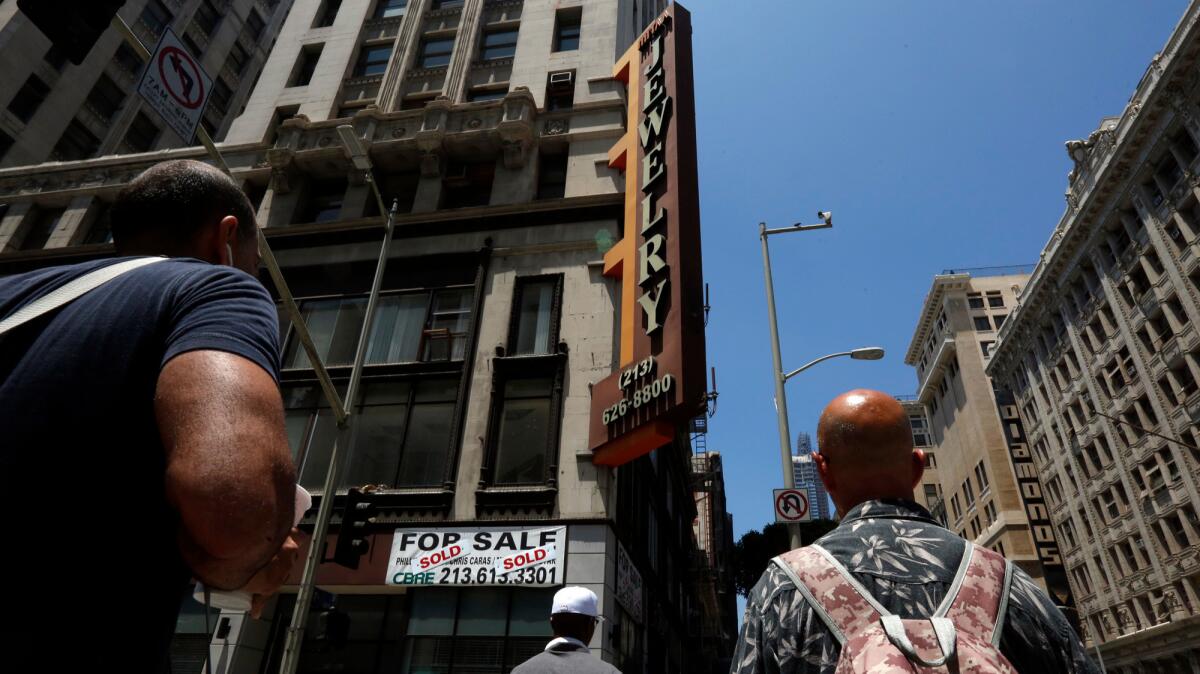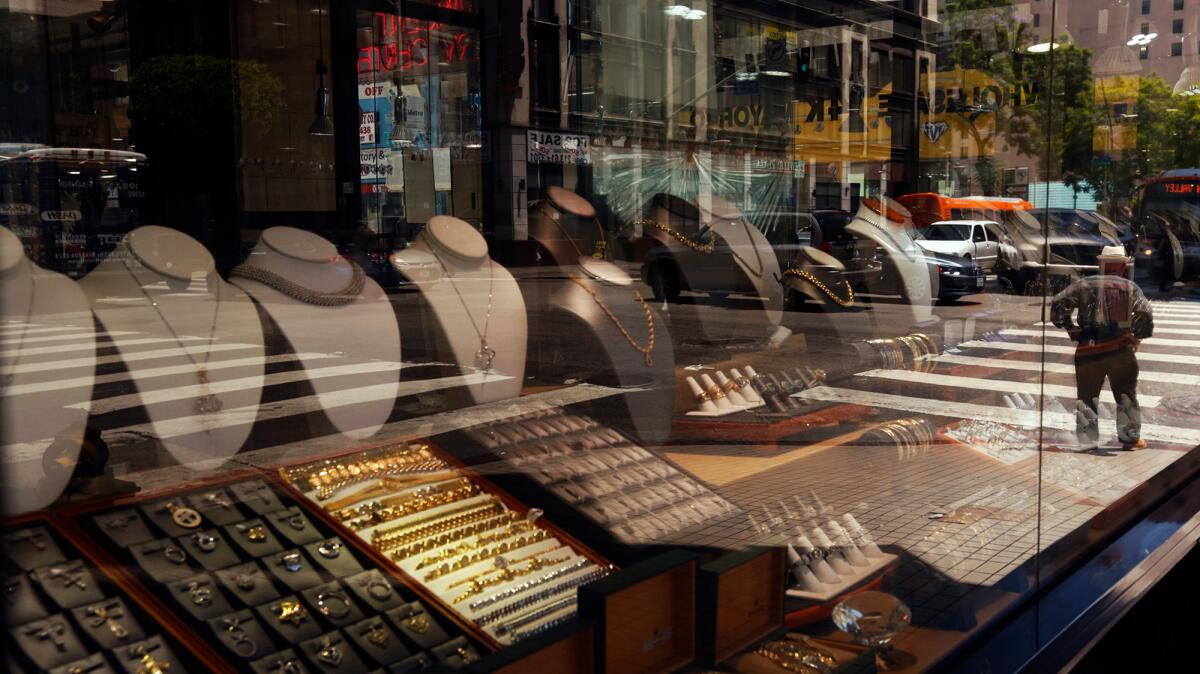Jewelry district struggles to maintain glitter in changing downtown

- Share via
Steve Altinis spends much of his time sitting at his desk at Tievoli Jewelers in downtown Los Angeles, waiting to greet customers.
But it can be a long wait these days. During one two-week stretch in July, not a single new face walked into the spacious store Altinis opened in 1980.
“In general, it’s totally dead,” Altinis said. “No business at all.”
Early on, business was good. In the 1980s, the Western Jewelry Mart in the old Hollingsworth Building at 6th and Hill streets in downtown L.A. often was packed, the main plaza floor bustling with activity.
The jewelry district was ideal for entrepreneurial immigrants, recalled Peklar Pilavjian, owner of the St. Vincent Jewelry Center and a diamond dealer by trade. All a business required was a bit of capital for the initial inventory and rent, and a hardworking family.
“The risk was low; the reward was high. The time you had to be there was flexible,” said Pilavjian, an Armenian immigrant from Lebanon. “This is comfortable living — or was anyway.”
Jewelry manufacturing in the district slowed in the 2000s, and since the 2008 recession, many sellers have struggled to survive in an industry whose lifeblood is the lure of luxury. Now that downtown L.A. is seeing an influx of capital from new developers, rising rents are adding to the strain felt by the craftsmen and small-business owners who kept the area alive in years past.
Working-class Latinos who helped sustain many downtown businesses are diminishing in numbers, while a growing Asian American population, including many wealthy Chinese immigrants, are drawn to luxury brands not found in the district.
“The jewelry business has changed a lot,” said Dione Kenyon, former president of the Jewelers Board of Trade, an industry group. “That has a lot to do with larger trends in our economy.”
The people who historically bought high-end jewelry in the downtown district aren’t shopping as much as they used to, say retailers and industry analysts.
“Baby boomers are now inching up toward their 60s,” said Pam Danziger, a researcher and author who studies affluent consumers. “The older you get … the less purchasing of luxury goods is something you feel you want or need to do.”
The young residents flocking to lofts and restaurants in downtown are not always affluent enough to make big jewelry purchases, nor do they necessarily want to, Danziger said.

On Broadway, where many stores selling gold and less pricey jewelry long thrived off a vibrant Latino consumer base, business is down too.
Ramin Refaiel, who is originally from Iran and owns a gold store on Broadway, became fluent in Spanish after working for years in retail downtown.
“The whole downtown turns on Latinos,” he said. “They come to buy their electronics here, a quinceañera dress across the street and a … perfume next door.”
Ten years ago, Refaiel hired Cintya Ortiz to help him with his Latino clientele. Ortiz said the majority of the shop’s customers are still Latinos, some coming from the Central Valley and even out of state. But there are far fewer, and they’re spending less, she said.
“Today, there’s not half the people there used to be,” Ortiz said.
Asians, who in 2010 overtook Latinos as the largest group of new immigrants to the U.S., could potentially make up for the lost business. But many of those consumers tend to be more interested in buying big brand names than in shopping at small businesses, industry analysts say.
“These people buy big,” said Ron Friedman, a consultant to retailers and manufacturers. “They’re buying a brand. They want brand. And I don’t know that the downtown jewelry industry will cater to them because they’re not branded.”
Diana Singer, president of the American Society of Jewelry Historians, said L.A.’s jewelry district, like New York’s, is struggling for another reason.
“It’s not that the industry is disappearing. It’s not that the infrastructure of the industry is disappearing,” Singer said. “It’s that the people who own the buildings want to maximize their investment, and they can get more if they do something else with it.”
Between 1997 and 2015, property values in downtown L.A. increased by 224%, according to a 2015 report by the Downtown Center Business Improvement District. Between 1999 and 2015, the number of residential units increased threefold, to more than 35,000.
“Real estate values have gone up so much that rental rates have no choice [but] to follow,” Pilavjian said. “That puts a tremendous amount of pressure on the mom-and-pop businesses.”

L.A.’s jewelry district, bounded roughly by 5th and 8th streets to the north and south, and Broadway and Olive to the east and west, is one of the country’s largest. The industry is difficult to track, but Pilavjian estimates there are up to 1,500 tenants, including many small, independent jewelers who rent booth space in the large jewelry plazas.
The district is part of downtown L.A.’s historic core. The Hollingsworth Building, for example, was completed in 1913; it later was purchased by the Western Federal Savings & Loan Assn. but didn’t become the Western Jewelry Mart until 1978.
Altinis, an immigrant from Turkey and the son of a jeweler, opened his store shortly after that. He named it partly after an Italian town that sounded like “Tiffany” and added an “e” to make the name even luckier: Read backward, Tievoli spells “I love it.”
At the time, the jewelry district consisted of one main facility, the California Jewelry Mart at 607 S. Hill St.

With the decline of manufacturing in the district, increased competition from the Internet and abroad, the lingering effects of the recession and rising rents downtown, comfortable living seems to be a thing of the past.
“Everybody’s just surviving now,” Refaiel said.
Many jewelers have been forced to shutter their doors. Across the U.S., more than 900 jewelry retailers, wholesalers and manufacturers closed between 2015 and 2016, according to figures provided by the Jewelers Board of Trade. Between 2004 and 2014, the number of jewelry retailers, wholesalers and manufacturers in L.A. County — with much of the business concentrated in the downtown jewelry district — fell from 2,173 to 1,915, according to data from the Los Angeles County Economic Development Corp.
On the Broadway side of the St. Vincent Jewelry Center, the basement and ground level are now occupied by a Burlington Coat Factory. In the past year, two other icons of the jewelry district, the International Jewelry Mart and the Foreman and Clark Building, were sold to large real estate firms, with talks of being renovated and repurposed for residential or mixed use.
“While maybe the jewelry district isn’t thriving as much as it once used to, the same intrinsic qualities of these buildings are in demand for other types of uses,” such as hotels, multifamily housing and creative office and retail space, said Mike Condon, executive managing director at Cushman & Wakefield, which handles the sale and leasing of buildings in the jewelry district.
In addition to changes in the overall economy, “The patterns of buying are changing, and the demographics are changing,” said Singer of the American Society of Jewelry Historians. Younger people prefer to buy antique or recycled jewelry and often shop online, she said.
Bob Baltayan runs a booth in the California Jewelry Mart with his wife, a third-generation Armenian jeweler. They used to sell a variety of jewelry, including big-ticket items like tennis bracelets and diamond studs, to repeat customers. Now, they sell mostly engagement rings and wedding bands to young buyers who don’t necessarily come back.
Baltayan said he and his wife don’t plan to pass the business on to their children.
“I don’t see a future in this,” he said. “It’s going to die out. At least small businesses like us.”
ALSO
Stingrays zap nearly 60 on Coronado
Head of DWP is seeking to retire, Garcetti aide says
More to Read
Sign up for Essential California
The most important California stories and recommendations in your inbox every morning.
You may occasionally receive promotional content from the Los Angeles Times.














